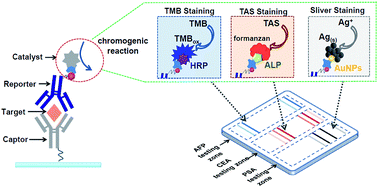Quantitative comparison of three representative staining methods for the development of multichannel colorimetric biochips†
Abstract
Assay staining is an essential step to produce visual signals for the development of colorimetric biochips; it is, therefore, of practical importance to evaluate the conventionally adopted staining methods in terms of their quantitative performance in screening immunoassay biochips. Particularly, we have performed a systematic comparison of the color development speed, sensitivity, response range, and aging effects of three common staining protocols, i.e., gold nanoparticle-catalyzed silver deposition (silver staining), horseradish peroxidase (HRP)-catalyzed oxidation of tetramethylbenzidine (TMB staining), and alkaline phosphatase (ALP)-catalyzed reduction of tetrazolium salt (TAS staining). Our results have revealed that silver staining can afford the best screening performance in terms of sensitivity, response range, and aging effect. In comparison, TMB staining is fast in producing quantitative results (5–10 min). TAS staining can provide easily saturated signals with a low background, which is suitable for semi-quantitative or qualitative on-site applications. More importantly, we have demonstrated that the three staining methods can be adapted to the same biochip to fabricate “multichannel” colorimetric biochips for screening multiple tumor markers simultaneously.

- This article is part of the themed collection: Analytical Methods Recent HOT articles


 Please wait while we load your content...
Please wait while we load your content...